See also Australian douche ad
(ca. 1900) - Fresca
douche powder (U.S.A.) (date ?) - Kotique douche liquid
ad, 1974 (U.S.A.) - Liasan
(1) genital wash ad, 1980s (Germany) - Liasan (2) genital wash
ad, 1980s (Germany) - Lysol
douche liquid ad, 1928 (U.S.A.) - Lysol douche liquid ad,
1948 (U.S.A.) - Marvel
douche liquid ad, 1928 (U.S.A.) - Midol menstrual pain
pill ad, 1938 (U.S.A.) - Midol
booklet (selections), 1959 (U.S.A.) - Mum deodorant cream ad,
1926 (U.S.A.) - Pristeen
genital spray ad, 1969 (U.S.A.) - Spalt pain tablets,
1936 (Germany) - Sterizol
douche liquid ad, 1926 (U.S.A.) - Vionell genital spray ad,
1970, with Cheryl Tiegs (Germany) - Zonite douche liquid ad,
1928 (U.S.A.)
The Perils of Vaginal
Douching (essay by Luci Capo Rome) - the odor page
And read Lynn Peril's series
about these and similar booklets!
See more Kotex items: First ad (1921) -
ad 1928 (Sears and
Roebuck catalog) - Lee
Miller ads (first real person in
amenstrual hygiene ad, 1928) - Marjorie May's Twelfth
Birthday (booklet for girls, 1928,
Australian edition; there are many links here to
Kotex items) - Preparing
for Womanhood (1920s, booklet for girls;
Australian edition) - 1920s booklet in Spanish
showing disposal
method - box
from about 1969 - "Are
you in the know?" ads (Kotex) (1949)(1953)(1964)(booklet, 1956) - See
more ads on the Ads for
Teenagers main page


|

Spalt menstrual-pain tablets ad
(1936, Germany, in Frauen Warte
magazine)
Women experience menstrual pain in
many cultures, maybe all; we know it
at least from the time of
fifth-century B.C.E. Greece, when the
disappearance of pain coinciding with
the appearance of bleeding amazed
Hippocrates, who then thought that
taking blood from men might cure their ills.
Nazi Germany was no exception, as
the ad below shows. Compare a Midol
menstrual-pain relief ad from almost
the same time in America.
Both illustrations come from the
book Die
unpäßliche Frau,
by Sabine Hering and Gudrun Maierhof
(Pfaffenweiler, Germany, 1991).
|
 |
"Spalt"
in German means "slot"
or "split,"
maybe referring to the prominently
shown feature that allows the tablet
to be easily broken in half. Or it
might be be someone's name. Or . . . .
The woman probably is wearing a
nurse's cap (which has disappeared in
the U.S.A.) thus making a medical
endorsement in the reader's mind,
something that Kotex, Modess and
probably many other brands in many
countries tried to create. Note the
calendar with a crossed-off day.
Here's my translation:
(slanted words at top): Days that you fear
(small words under the top
picture): These
days
are disagreeable enough. You at
least try to battle the pain. The
well-known "Spalt tablets" are
designed just for headaches and
other pains in critical days [code
words for the days of menstruation;
see other words
for menstruation]. Spalt tablets are
made so they fight the cramp origins
of headache. For your convenience,
each pack of twenty comes with an
extra little tin, enabling you to
carry a few tablets with you. [Neat!
Americans used to be able to buy
aspirin in tins.]
Price: ten for 62 Pfennigs, 20 for
one Reichs Mark and 16 Pfennigs and
60 for two Reichs Marks and 85
Pfennigs. Available in all
pharmacies. [In Germany,
people buy drugs in pharmacies and buy
many of the other things that
Americans find in their drugstores in
a Drogerie, which does not sell
prescription drugs. There'll be a quiz
tomorrow.]
|
 |
The Spalt ad appeared
in a 1936 issue of the magazine above;
this is a later front cover.
Frauen Warte means "Women's Watch Tower,"
or,
figuratively perhaps, "Women's Viewpoint."
The
Nazis idealized these strapping German
women with their blonde bouncing Bubs
and Mädels - a Bub, pronounced
"boob," probably to your astonishment,
is colloquial German for "boy, " and a
Mädel is a - Yes! You've got it!
- girl.
The "NS," below
the swastika (upper left), stands for
"Nazionalsozialismus,"
National Socialism, which most people
shorten to Nazis,
the political group that ran Germany
from the early 1930s to 1945. The
peculiar style of the letters reflects
the Nazis' attempt to bring German
origins to peoples' consciousness,
because the letters imitate the runes, a
writing system of very early Germans
and Scandinavians (runes supposedly
have been found in the U.S.A.).
Underneath Frauen Warte
we read, "The
only official party magazine for
women," party meaning, of
course, the Nazi party, not
Martha-Stewart-like advice on how to
throw one.
Then, below, it reads,
"the 23rd issue of the seventh volume,
1 May 1939. Mothers
Day, 1939."
The Germans would start World War II
in Europe in a little over four
months.
See
also ads (in German) from the
catalog of the German company Thalysia, showing douche and
menstruation supplies, 1933.
|
NEXT: Vionell genital
spray ad (Germany)
© 2000 Harry Finley. It is
illegal to reproduce or distribute
any of the work on this Web site in
any manner or medium
without written permission of the
author. Please report
suspected violations to hfinley@mum.org
See also
Australian
douche ad (ca. 1900) - Fresca douche
powder (U.S.A.) (date ?) - Kotique
douche liquid ad, 1974 (U.S.A.) - Liasan (1)
genital wash ad, 1980s (Germany) - Liasan (2)
genital wash ad, 1980s (Germany) - Lysol douche
liquid ad, 1928 (U.S.A.) - Lysol douche
liquid ad, 1948 (U.S.A.) - Marvel douche
liquid ad, 1928 (U.S.A.) - Midol
menstrual pain pill ad, 1938 (U.S.A.)
- Midol
booklet (selections), 1959
(U.S.A.) - Mum
deodorant cream ad, 1926 (U.S.A.) - Pristeen
genital spray ad, 1969 (U.S.A.) - Spalt pain
tablets, 1936 (Germany) - Sterizol
douche liquid ad, 1926 (U.S.A.) - Vionell genital
spray ad, 1970, with Cheryl Tiegs
(Germany) - Zonite
douche liquid ad, 1928 (U.S.A.)
The Perils of
Vaginal Douching (essay by Luci
Capo Rome) - the odor
page
|
|




